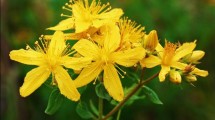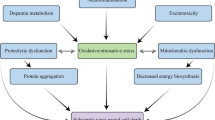Abstract
Sorghum stem (Sorghum bicolor) has been in use in traditional medicine systems for the management of neurodegenerative conditions. However, there is dearth of information on the scientific basis for its use in the treatment of such conditions. This study sought to assess the antioxidant activity and effects of phenolic extract from sorghum stem (Sorghum bicolor) on some cholinergic (acetylcholinesterase (AChE)) and purinergic (Na+/K+-ATPase and ecto-5′-nucleotidase) enzymes associated with neurological conditions. Phenolic-rich extract was prepared using methanol: 1 N HCl (1:1, v/v) mixture and characterized using high-performance liquid chromatography-diode array detector (HPLC-DAD). In vitro tests were used to investigate the effects of the phenolic extract on AChE, Na+/K+-ATPase, and ecto-5′-nucleotidase activities. Furthermore, the hydroxyl (OH) radical scavenging and Fe2+-chelating abilities of the extract were investigated. HPLC-DAD analysis revealed the presence of some phenolic acids such as caffeic acid (120.58 mg/g), ferulic acid (76.45 mg/g), gallic acid (17.48 mg/g), chlorogenic acid (16.25 mg/g), and flavonoids such as kaempferol (15.98 mg/g), rutin (51.07 mg/g), quercetin (263.16 mg/g), and quercitrin (89.21 mg/g) in the phenolic extract. The extract significantly inhibited AChE and ecto-5′-nucleotidase activities in a dose dependent manner with IC50 = 24.88 μg/ml and IC50 = 37.49 μg/ml, respectively, and increased Na+/K+-ATPase activity in a dose dependent manner. Furthermore, the phenolic extract also scavenged OH radicals and was able to chelate Fe2+ in a dose dependent manner with IC50 = 54.27 μg/ml and 18.47 μg/ml, respectively. This study revealed the antioxidant and modulatory effects of phenolic extracts from sorghum stem on some cholinergic and purinergic enzymes.





Similar content being viewed by others
References
Abbas SR, Sabir SM, Ahmad SD, Boligon AA, Athayde ML (2014) Phenolic profile, antioxidant potential and DNA damage protecting activity of sugarcane (Saccharum officinarum). Food Chem 147:10–16
Ademosun AO, Oboh G (2012) Inhibition of acetylcholinesterase activity and Fe2+-induced lipid peroxidation in rat brain in vitro by some citrus fruit juices. J Med Food 15(5):428–434
Ademosun AO, Oboh G (2014) Comparison of the inhibition of monoamine oxidase and butyrylcholinesterase activities by infusions from green tea and some citrus peels. I J Alz Dis, http://dx.doi.org/10.1155/2014/586407
Arnaiz GR, Ordieres MGL (2014) Brain Na+, K+-ATPase activity in aging and disease. Int J Biomed Sci 10(2):85–102
Bakasso S, Lamien-meda A, Lamien CE, Kiendrebeogo M, Coulibaly AY, Compaoré M, Meda NR, Nacoulma OG (2013) In vitro inhibition of acetyl cholinesterase, lipoxygenase, xanthine oxidase and antibacterial activities of five Indigofera (Fabaceae) aqueous acetone extracts from Burkina Faso. Current Research J Biol Sci 5(3):115–122
Boligon AA, Kubiça TF, Mario DN, Brum TF, Piana M, Weiblen R, Lovato L, Alves SH, Santos RCV, Alves CFS, Athayde ML (2013) Antimicrobial and antiviral activity-guided fractionation from Scutia buxifolia Reissek extracts. Acta Physiol Plant 35:2229–2239
Boligon AA, Pimentel CA, Bagatini MD, Athayde ML (2015) Effect of Scutia buxifolia Reissek in nucleotidase activities and inhibition of platelet aggregation. J Nat Med 69(1):46–54
Burnstock G (2007) Physiology and pathophysiology of purinergic neurotransmission. Physiol Rev 87(2):659–797
Burnstock G (2008) Purinergic signalling and disorders of the central nervous system. Nat Rev Drug Disc 7:575–590
Di Iorio P, Ballerini P, Caciagli F, Ciccarelli R (1998) Purinoceptor mediated modulation of purine and neurotransmitter release from nervous tissue. Pharmacol Res 37(3):169–78
Ferrerira A, Proenc C, Serralheiro MLM, Arajo MEM (2006) The in vitro screening for acetylcholinesterase inhibition and antioxidant activity of medicinal plants from Portugal. J Ethnopharmacol 108:31–37
Fiske CH, Subbarow Y (1925) The colorimetric determination of phosphorous. J Biol Chem 66:375–400
de Giana P, Cognato G, Bonan CD (2010) Ectonucleotidases and epilepsy. Open Neurosci J 4:44–52
Halliwell B, Gutteridge JM, Aruoma OI (1981) The deoxyribose method: simple “test-tube” assay for determination of rate constants for reactions of hydroxyl radicals. Ann Rev Biochem 165:215–219
Hasnat MA, Pervin M, Lim BO (2013) Acetylcholinesterase inhibition and in vitro and in vivo antioxidant activities of Ganoderma lucidum Grown on germinated brown rice. Mol 18:6663–6678
Heymann D, Reddington M, Kreutzberg GW (1984) Subcellular localization of 5’-nucleotidase in rat brain. J Neurochem 43:971–978
Howes MJ, Houghton PJ (2003) Plants used in Chinese and Indian traditional medicine for improvement of memory and cognitive function. Pharmacol Biochem Behav 75:513–527
Ilori OO, Odukoya OA (2005) Hibiscus sabdarifa and Sorghum bicolor as natural colorants. J Environ Agric Food Chem 4:858–62
Javorková V, Pechánová O, Andriantsitohaina R, Vrbjar N (2003) Effect of polyphenolic compounds on the renal Na+, K + -ATPase during the restoration of normotension after experimentally induced hypertension in rats. Exp Physiol 88(4):475–482
Jung M, Park M (2007) Acetylcholinesterase inhibition by flavonoids from Agrimonia pilosa. Molecules 12:2130–2139
Kinsella K, Wan H (2009) “An ageing world”. US Census Bureau, international population reports P 95/09-1. US Government Printing Office, Washington
Kitakaze M, Minamino T, Node K, Komamura K, Inoue M, Hori M, Kamade T (1996) Activation of ecto-5-nucleotidase by protein kinase C attenuates irreversible cellular injury due to hypoxia and reoxygenation in rat cardiomyocytes. J Mol Cell Cardiol 28:1945–1955
Lees GJ (1991) Inhibition of sodium-potassium-ATPase: a potentially ubiquitous mechanism contributing to central nervous system neuropathology. Brain Res Rev 16:283–300
Maneva A, Taleva B (2008) Effect of some flavonic compounds and ascorbic acid on lactoferrin stimulation of erythrocyte glycolysis and Na+/K+-atpase activity. Zeitchrift Naturforschung C 63:773–779
Marksberry WR, Lovell MA (2007) Damage to lipids, proteins, DNA and RNA in mild cognitive impairment. Arch Neurol 64:954–956
Minamino T, Kitakaze M, Morioka T, Node K, Komamura K, Takeda H, Inoue M, Hori M, Kamada T (1996) Cardioprotection due to preconditioning correlates with increased ecto-5-nucleotidase activity. Am J Physiol 270:238–244
Minotti G, Aust S (1987) An investigation into the mechanism of citrate-Fe2+ dependent lipid peroxidation. Free Rad Biol Med 3:379–387
Mishra N, Rizvi SI (2012) Quercetin modulates Na+/K+ ATPase and sodium hydrogen exchanger in type 2 diabetic erythrocytes. Cell Mol Biol 58(1):148–152
Mukherjee PK, Kumar V, Mal M, Houghton PJ (2007) Acetylcholinesterase inhibitors from plants. Phytomedicine 14(4):289–300
Mutegi E, Sagnard F, Muraya M, Kanyenji B, Rono B, Mwongera C (2010) Ecogeographical distribution of wild, weedy and cultivated Sorghum bicolor (L.) Moench in Kenya: implications for conservation and crop-to-wild gene flow. Genet Resour Crop Evol 57:243–53
Oboh G, Agunloye OM, Akinyemi AJ, Ademiluyi AO, Adefegha SA (2013) Comparative study on the inhibitory effect of caffeic and chlorogenic acids on key enzymes linked to Alzheimer’s disease and some pro-oxidant induced oxidative stress in rats’ brain-in vitro. Neurochem Res 38:413–419
Ohno K, Engel AG, Brengman JM, Shen XM, Heidenreich F, Vincent A, Milone M, Tan E, Demirci M, Walsh P, Nakano S, Akiguchi I (2000) The spectrum of mutations causing end-plate acetylcholinesterase deficiency. Ann Neurol 47:162–170
Perry E, Walker M, Grace J, Perry R (1999) Acetylcholine in mind: a neurotransmitter correlate of consciousness? Trends Neurosci 22(6):273–280
Perry NS, Houghton PJ, Theobald A, Jenner P, Perry EK (2000) In-vitro inhibition of human erythrocyte acetylcholinesterase by Salvia lavandulaefolia essential oil and constituent terpenes. J Pharm Pharmacol 52(7):895–902
Pohanka M (2014) Inhibitors of acetylcholinesterase and butyrylcholinesterase meet immunity. Int J Mol Sci 15:9809–9825
Polinsky RJ, Holmes KV, Brown RT, Weise V (1989) CSF acetylcholinesterase levels are reduced in multiple system atrophy with autonomic failure. Neurol 39:40–44
Pratico D, Delanty N (2000) Oxidative injury in diseases of the central nervous system: focus on Alzheimer’s disease. Am J Med 109:577–585
Puntel RL, Nogueira CW, Rocha JBT (2005) Krebs cycle intermediates modulate thiobarbituric reactive species (TBARS) production in rat brain in vitro. Neurochem Res 30:225–235
Ribeiroa CAJ, Hickmann FH, Wajner M (2011) Neurochemical evidence that 3-methylglutaric acid inhibits synaptic Na+, K+-ATPase activity probably through oxidative damage in brain cortex of young rats. Int J Devl Neuroscience 29:1–7
Robson S, Sévigny J, Zimmermann H (2006) The E-NTPDase family of ectonucleotidases: structure function relationships and pathophysiological significance. Purinergic Signal 2:409–30
Scalbert A, Manach C, Morand C, Rémésy C, Jiménez L (2005) Dietary polyphenols and the prevention of diseases. Crit Rev Food Sci Nutr 45(4):287–306
Scheiner-Bobis G (2002) The sodium pump. Its molecular properties and mechanics of ion transport. Eur J Biochem 269:2424–2433
Slemmer JE, Shacka JJ, Sweeney MI, Weber JT (2008) Antioxidants and free radical scavengers for the treatment of stroke, traumatic brain injury and aging. Curr Med Chem 15:404–414
Taylor JRN, Belton PS, Beta T, Duodu KG (2014) Increasing the utilisation of sorghum, millets and pseudocereals: developments in the science of their phenolic phytochemicals, biofortification and protein functionality. J Cereal Sci 59:257–275
Valko M, Leibfritz D, Moncol J, Mark TD, Mansur CM, Tesler J (2007) Free radicals and antioxidants in normal physiological functions and human disease. Int J Biochem Cell Biol 39:44–84
Volonté C, Amadio S, Cavaliere F, D’Ambrosi N, Vacca F, Bernardi G (2003) Extracellular ATP and neurodegeneration. Curr Drug Targets CNS Neurol Disord 2:403–412
Wyse AT, Bavaresco CS, Reis EA, Zugno AI, Tagliari B, Calcagnotto T, Netto CA (2004) Training in inhibitory avoidance causes a reduction of Na+, K+-ATPase activity in rat hippocampus. Physiol Behav 80(4):475–479
Wyse AT, Streck EL, Worm P, Wajner A, Ritter F, Netto CA (2000) Preconditioning prevents the inhibition of Na+/K+-ATPase activity after brain ischemia. Neurochem Res 25:969–973
Zago MP, Verstraeten SV, Oteiza PI (2000) Zinc in the prevention of Fe2+ initiated lipid and protein oxidation. Biol Res 33:143–150
Zar JH (1984) Biostatistical analysis. Prentice-Hall, Inc, USA, p 620
Author information
Authors and Affiliations
Corresponding author
Rights and permissions
About this article
Cite this article
Oboh, G., Adewuni, T.M., Ademosun, A.O. et al. Sorghum stem extract modulates Na+/K+-ATPase, ecto-5′-nucleotidase, and acetylcholinesterase activities. Comp Clin Pathol 25, 749–756 (2016). https://doi.org/10.1007/s00580-016-2259-4
Received:
Accepted:
Published:
Issue Date:
DOI: https://doi.org/10.1007/s00580-016-2259-4




